Selective Sensing of Gas Mixture via a Temperature Modulation Approach: New Strategy for Potentiometric Gas Sensor Obtaining Satisfactory Discriminating Features
Abstract
:1. Introduction
2. Materials and Methods
2.1. Sample Preparation and Fabrication of the Sensor
2.2. Characterization of Sensing Characteristics
3. Results and Discussion
4. Conclusions
Acknowledgments
Author Contributions
Conflicts of Interest
Abbreviations
| YSZ | Yttria-Stabilized Zirconia |
| SE | Sensing Electrode |
| RE | Reference Electrode |
| PCA | principle component analysis |
References
- Karthikeyan, S.; Prathima, A.; Sabariswaran, K. An environmental effect of nano additive on performance and emission in a biofuel fuelled marine engine. Indian J. Geo. Mar. Sci. 2015, 44, 896–901. [Google Scholar]
- Tzamkiozis, T.; Ntziachristos, L.; Samaras, Z. Diesel passenger car pm emissions: From euro 1 to euro 4 with particle filter. Atmos. Environ. 2010, 44, 909–916. [Google Scholar] [CrossRef]
- O’Driscoll, R.; ApSimon, H.M.; Oxley, T.; Molden, N.; Stettler, M.E.J.; Thiyagarajah, A. A portable emissions measurement system (pems) study of nox and primary NO2 emissions from euro 6 diesel passenger cars and comparison with copert emission factors. Atmos. Environ. 2016, 145, 81–91. [Google Scholar] [CrossRef]
- Zhang, H.; Wang, J.M.; Wang, Y.Y. Sensor reduction in diesel engine two-cell selective catalytic reduction (scr) systems for automotive applications. IEEE-ASME Trans. Mechatron. 2015, 20, 2222–2233. [Google Scholar] [CrossRef]
- Simons, H.; Simon, U. Zeolites as nanoporous, gas-sensitive materials for in situ monitoring of denox-scr. Beilstein J. Nanotechnol. 2012, 3, 667–673. [Google Scholar] [CrossRef] [PubMed]
- Hannon, A.; Lu, Y.; Li, J.; Meyyappan, M. A sensor array for the detection and discrimination of methane and other environmental pollutant gases. Sensors 2016, 16, 1163. [Google Scholar] [CrossRef] [PubMed]
- Chiu, S.W.; Tang, K.T. Towards a chemiresistive sensor-integrated electronic nose: A review. Sensors 2013, 13, 14214–14247. [Google Scholar] [CrossRef] [PubMed]
- Miura, N.; Sato, T.; Anggraini, S.A.; Ikeda, H.; Zhuiykov, S. A review of mixed-potential type zirconia-based gas sensors. Ionics 2014, 20, 901–925. [Google Scholar] [CrossRef]
- Rheaume, J.M.; Pisano, A.P. A review of recent progress in sensing of gas concentration by impedance change. Ionics 2011, 17, 99–108. [Google Scholar] [CrossRef]
- Zou, J.; Zheng, Y.; Li, J.; Zhan, Z.; Jian, J. Potentiometric NO2 sensors based on thin stabilized zirconia electrolytes and asymmetric (La0.8Sr0.2)0.95MnO3 electrodes. Sensors 2015, 15, 17558–17571. [Google Scholar] [CrossRef] [PubMed]
- Lu, G.; Miura, N.; Yamazoe, N. High-temperature hydrogen sensor based on stabilized zirconia and a metal oxide electrode. Sens. Actuators B Chem. 1996, 35–36, 130–135. [Google Scholar] [CrossRef]
- Yamaura, H.; Jinkawa, T.; Tamaki, J.; Moriya, K.; Miura, N.; Yamazoe, N. Indium oxide-based gas sensor for selective detection of CO. Sens. Actuators B Chem. 1996, 36, 325–332. [Google Scholar] [CrossRef]
- Ueda, T.; Plashnitsa, V.V.; Nakatou, M.; Miura, N. Zirconia-based amperometric sensor using zno sensing-electrode for selective detection of propene. Electrochem. Commun. 2007, 9, 197–200. [Google Scholar] [CrossRef]
- Jin, H.; Breedon, M.; Miura, N. Sensing behavior of YSZ-based amperometric NO2 sensors consisting of Mn-based reference-electrode and In2O3 sensing-electrode. Talanta 2012, 88, 318–323. [Google Scholar] [CrossRef] [PubMed]
- Lee, I.; Jung, B.; Park, J.; Lee, C.; Hwang, J.; Park, C.O. Mixed potential NH3 sensor with LaCoO3 reference electrode. Sens. Actuators B Chem. 2013, 176, 966–970. [Google Scholar] [CrossRef]
- Dai, L.; Liu, Y.; Meng, W.; Yang, G.; Zhou, H.; He, Z.; Li, Y.; Wang, L. Ammonia sensing characteristics of La10Si5MgO26-based sensors using In2O3 sensing electrode with different morphologies and cuo reference electrode. Sens. Actuators B Chem. 2016, 228, 716–724. [Google Scholar] [CrossRef]
- Liu, F.; Guan, Y.; Sun, H.; Xu, X.; Sun, R.; Liang, X.; Sun, P.; Gao, Y.; Lu, G. Ysz-based NO2 sensor utilizing hierarchical In2O3 electrode. Sens. Actuators B Chem. 2016, 222, 698–706. [Google Scholar] [CrossRef]
- Miura, N.; Shiraishi, T.; Shimanoe, K.; Yamazoe, N. Mixed-potential-type propylene sensor based on stabilized zirconia and oxide electrode. Electrochem. Commun. 2000, 2, 77–80. [Google Scholar] [CrossRef]
- Miura, N.; Raisen, T.; Lu, G.; Yamazoe, N. Highly selective CO sensor using stabilized zirconia and a couple of oxide electrodes. Sens. Actuators B Chem. 1998, 47, 84–91. [Google Scholar] [CrossRef]
- Sun, F.; Li, X.; Liu, L.; Wang, J. Novel Zn–M–O (M = Sn, Co) sensing electrodes for selective mixed potential CO/C3H8 sensors. Sens. Actuators B Chem. 2013, 184, 220–227. [Google Scholar] [CrossRef]
- Li, X.; Kale, G.M. Influence of thickness of ito sensing electrode film on sensing performance of planar mixed potential CO sensor. Sens. Actuators B Chem. 2006, 120, 150–155. [Google Scholar] [CrossRef]
- Chen, Y.; Xiao, J. Effects of ysz addition on the response of La2CuO4 sensing electrode for a potentiometric NOx sensor. Sens. Actuators B Chem. 2014, 192, 730–736. [Google Scholar]
- Li, X.; Wang, C.; Wang, B.; Yuan, Y.; Huang, J.; Zhang, H.; Xia, F.; Xiao, J. Effects of sintering temperature on the NH3 sensing properties of Mg2Cu0.25Fe1O3.75 electrode for ysz-based potentiometric NH3 sensor. Ceram. Int. 2016, 42, 2214–2220. [Google Scholar] [CrossRef]
- Hu, X.; Tian, L.; Sun, H.; Wang, B.; Gao, Y.; Sun, P.; Liu, F.; Lu, G. Highly enhanced NO2 sensing performances of Cu-doped In2O3 hierarchical flowers. Sens. Actuators B Chem. 2015, 221, 297–304. [Google Scholar] [CrossRef]
- Zhang, D.; Liu, Z.; Li, C.; Tang, T.; Liu, X.; Han, S.; Lei, B.; Zhou, C. Detection of NO2 down to ppb levels using individual and multiple In2O3 nanowire devices. Nano Lett. 2004, 4, 1919–1924. [Google Scholar] [CrossRef]
- Tomchenko, A.A.; Harmer, G.P.; Marquis, B.T.; Allen, J.W. Semiconducting metal oxide sensor array for the selective detection of combustion gases. Sens. Actuators B Chem. 2003, 93, 126–134. [Google Scholar] [CrossRef]
- Natale, C.D.; Davide, F.A.M.; Amico, A.D.; Sberveglieri, G.; Nelli, P.; Faglia, G.; Perego, C. Complex chemical pattern recognition with sensor array the discrimination of vintage years of wine. Sens. Actuators B Chem. 1995, 25, 801–804. [Google Scholar] [CrossRef]
- Sheini, A.; Khajehsharifi, H.; Shahbazy, M.; Kompany-Zareh, M. A chemosensor array for the colorimetric identification of some carboxylic acids in human urine samples. Sens. Actuators B Chem. 2017, 242, 288–298. [Google Scholar] [CrossRef]
- Li, D.; Lei, T.; Zhang, S.; Shao, X.; Xie, C. A novel headspace integrated E-nose and its application in discrimination of chinese medical herbs. Sens. Actuators B Chem. 2015, 221, 556–563. [Google Scholar] [CrossRef]
- Zhang, L.; Tian, F.; Peng, X.; Dang, L.; Li, G.; Liu, S.; Kadri, C. Standardization of metal oxide sensor array using artificial neural networks through experimental design. Sens. Actuators B Chem. 2013, 177, 947–955. [Google Scholar] [CrossRef]
- Zampolli, S.; Elmi, I.; Ahmed, F.; Passini, M.; Cardinali, G.C.; Nicoletti, S.; Dori, L. An electronic nose based on solid state sensor arrays for low-cost indoor air quality monitoring applications. Sens. Actuators B Chem. 2004, 101, 39–46. [Google Scholar] [CrossRef]

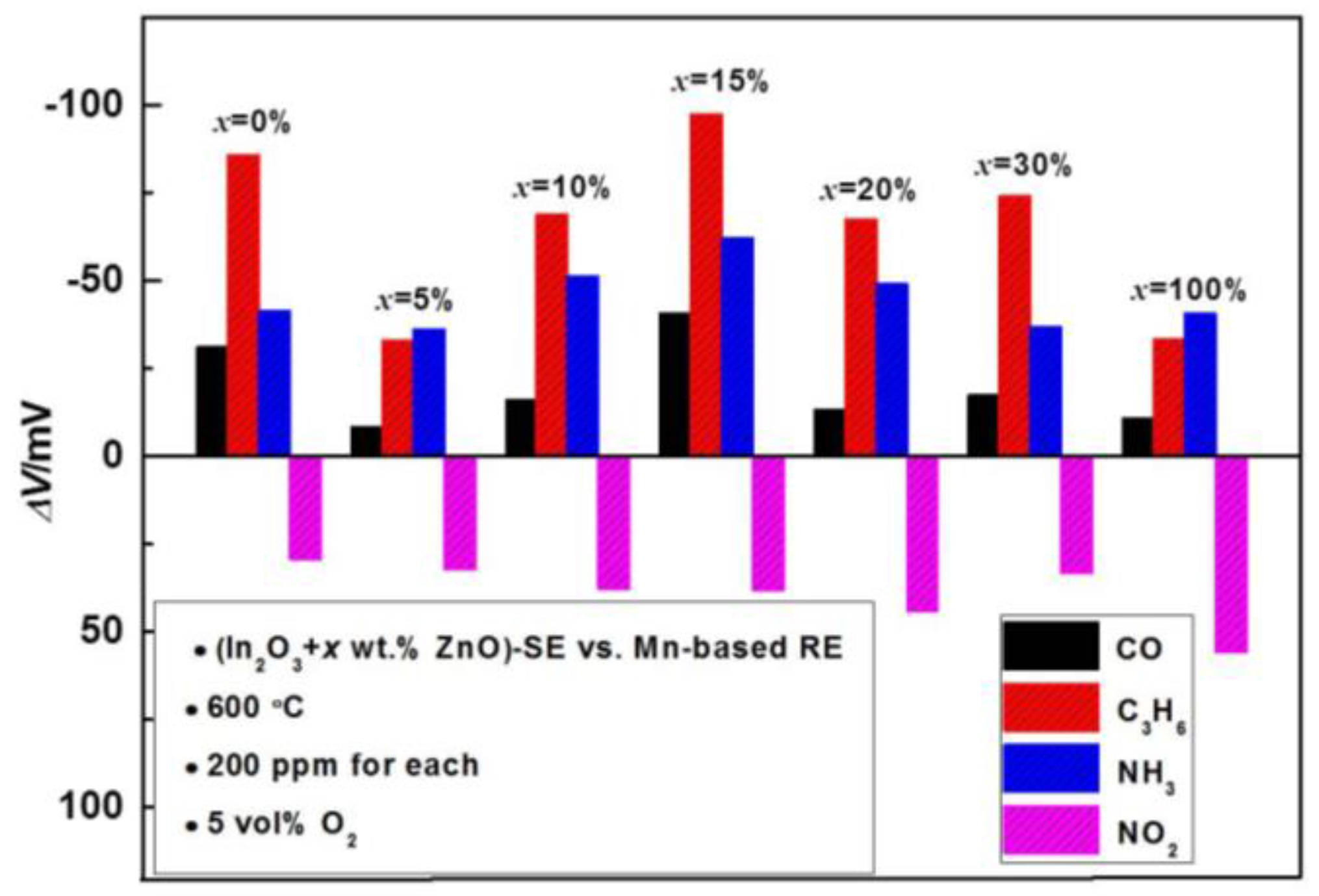

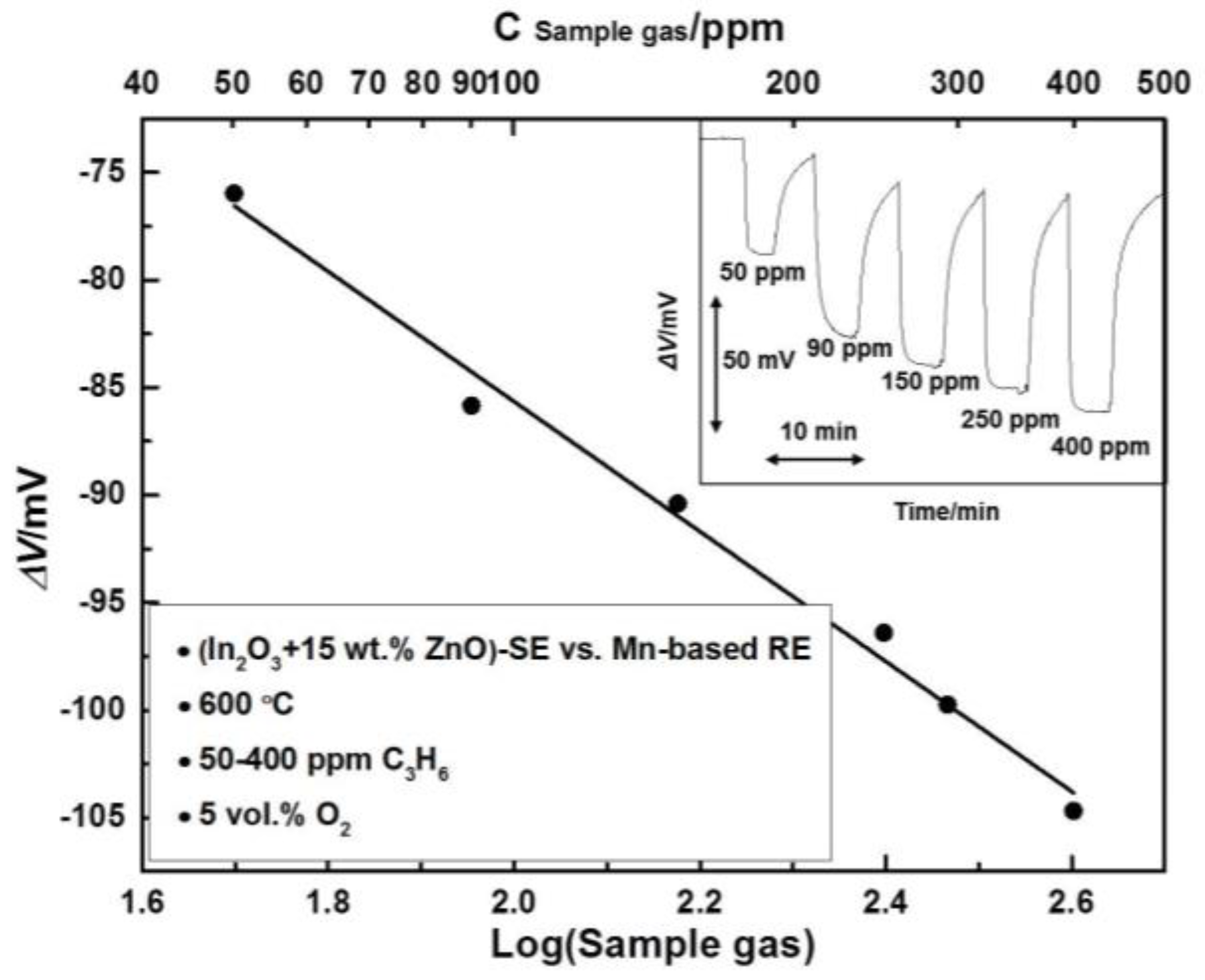
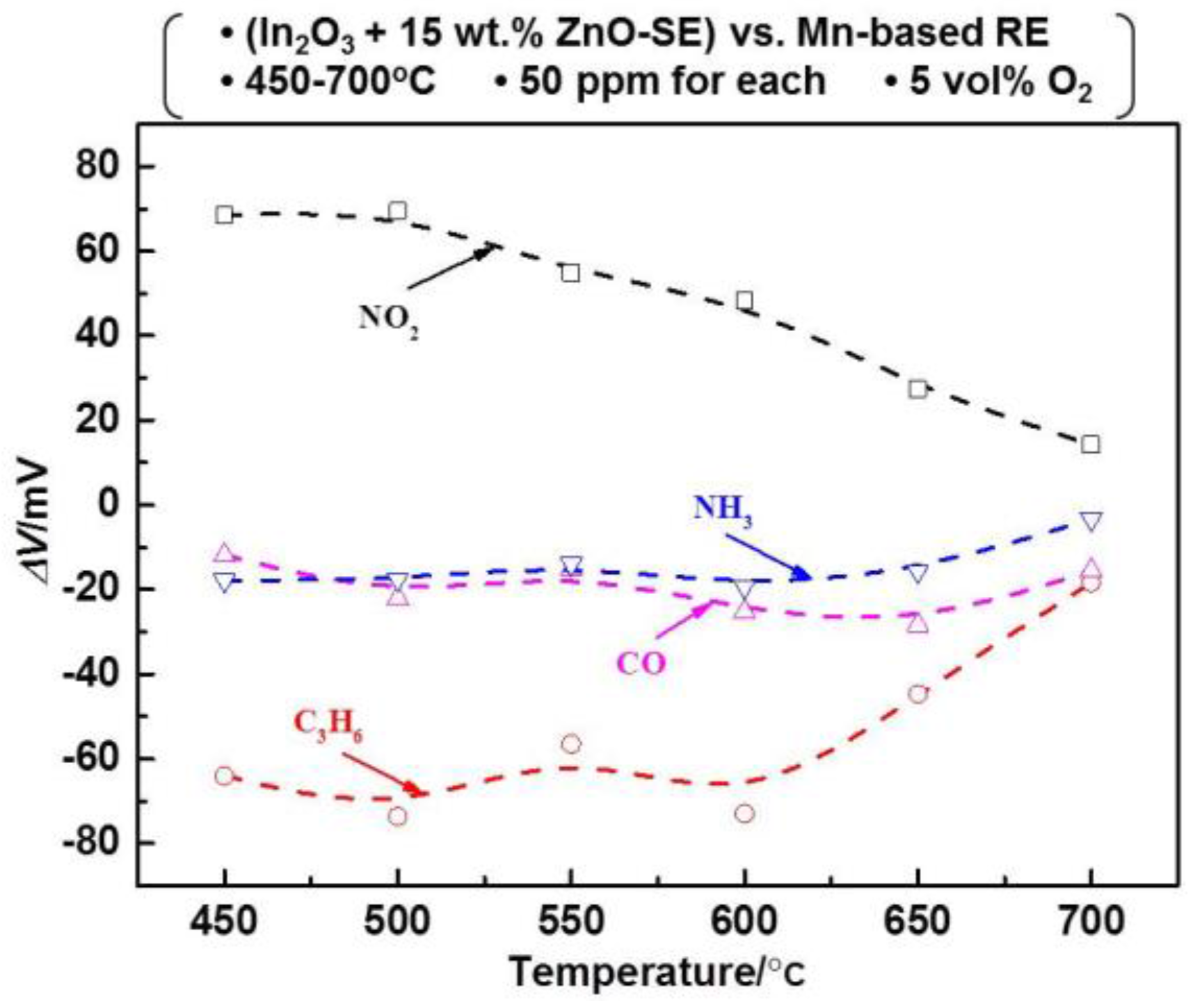
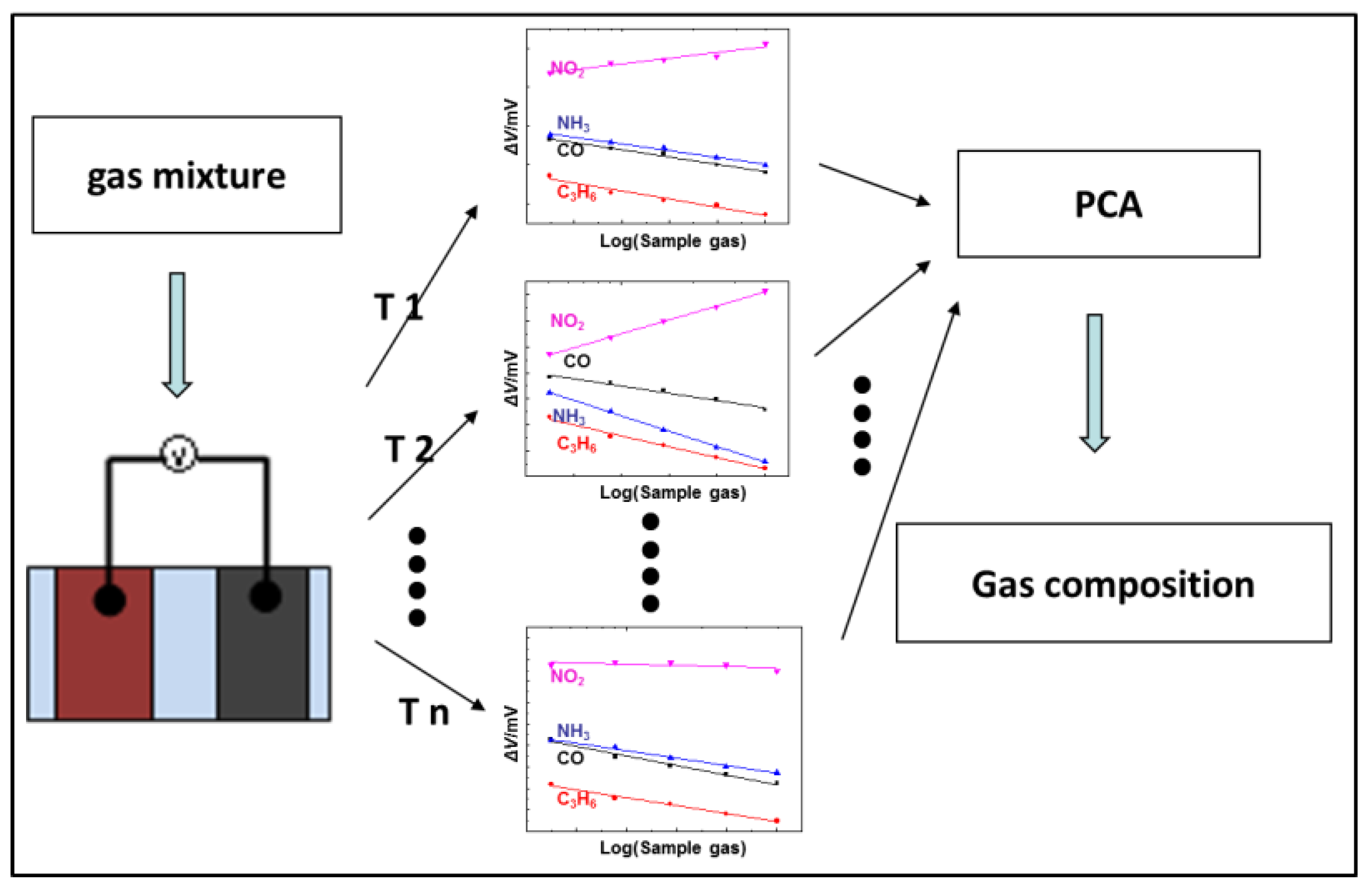
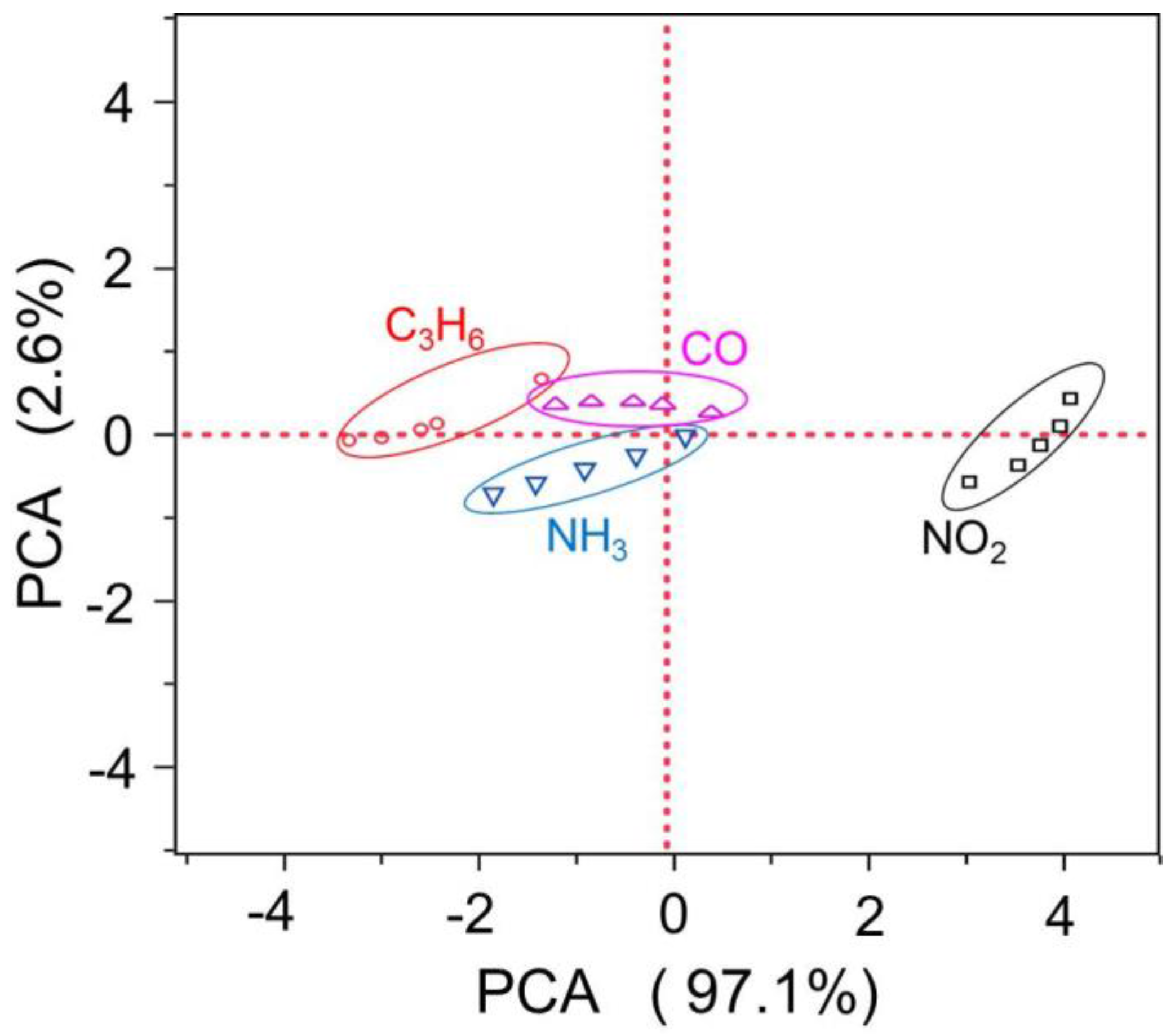
| Mill Media | Formula (g) | ||||||
|---|---|---|---|---|---|---|---|
| Mat. | Initial wt. | acrylic resin | Butyl acetate | Xylene | 8YSZ | PVB | PEG |
| ZrO2 | 800 g | 16 | 25.4 | 25.4 | 200 | 20 | 10 |
| Sample Gas | Concentration/ppm | Response at Various Operating Temperatures/mV | |||||
|---|---|---|---|---|---|---|---|
| Operating Temperature | |||||||
| 450 °C | 500 °C | 550 °C | 600 °C | 650 °C | 700 °C | ||
| CO | 50 | −17.86 | −17.58 | −13.98 | −19.32 | −15.64 | −3.36 |
| 90 | −28.80 | −29.52 | −30.65 | −32.47 | −25.07 | −8.19 | |
| 150 | −35.55 | −38.18 | −38.89 | −42.59 | −29.41 | −13.59 | |
| 250 | −49.86 | −48.76 | −47.51 | −49.79 | −37.41 | −20.62 | |
| 400 | −59.84 | −57.19 | −55.35 | −60.04 | −44.59 | −28.60 | |
| C3H6 | 50 | −64.00 | −73.63 | −56.55 | −72.98 | −44.70 | −18.36 |
| 90 | −85.79 | −90.31 | −69.14 | −88.84 | −81.54 | −49.13 | |
| 150 | −95.33 | −87.33 | −74.55 | −88.39 | −85.39 | −56.04 | |
| 250 | −101.95 | −92.90 | −83.55 | −98.40 | −94.02 | −65.11 | |
| 400 | −113.98 | −106.38 | −90.32 | −97.68 | −101.02 | −73.50 | |
| NH3 | 50 | −11.85 | −22.04 | −15.27 | −25.23 | −28.34 | −15.47 |
| 90 | −20.89 | −31.12 | −21.69 | −32.46 | −46.30 | −29.93 | |
| 150 | −27.35 | −37.71 | −31.58 | −50.86 | −59.13 | −44.26 | |
| 250 | −40.60 | −47.75 | −39.50 | −57.74 | −72.44 | −57.34 | |
| 400 | −50.66 | −59.53 | −45.50 | −65.48 | −84.14 | −68.49 | |
| NO2 | 50 | 68.49 | 69.45 | 54.76 | 48.34 | 27.39 | 14.27 |
| 90 | 81.07 | 80.73 | 57.42 | 58.15 | 41.94 | 27.01 | |
| 150 | 84.90 | 86.86 | 56.96 | 60.37 | 49.97 | 39.47 | |
| 250 | 89.57 | 88.81 | 54.94 | 61.28 | 56.48 | 50.57 | |
| 400 | 105.53 | 73.11 | 49.51 | 56.35 | 61.79 | 63.01 | |
| Sensor 1 | Sensor 2 | Sensor 3 | Sensor 4 | Sensor 5 | Sensor 6 | ||
| Virtual Sensor Array | |||||||
© 2017 by the authors. Licensee MDPI, Basel, Switzerland. This article is an open access article distributed under the terms and conditions of the Creative Commons Attribution (CC BY) license ( http://creativecommons.org/licenses/by/4.0/).
Share and Cite
Li, F.-a.; Jin, H.; Wang, J.; Zou, J.; Jian, J. Selective Sensing of Gas Mixture via a Temperature Modulation Approach: New Strategy for Potentiometric Gas Sensor Obtaining Satisfactory Discriminating Features. Sensors 2017, 17, 573. https://doi.org/10.3390/s17030573
Li F-a, Jin H, Wang J, Zou J, Jian J. Selective Sensing of Gas Mixture via a Temperature Modulation Approach: New Strategy for Potentiometric Gas Sensor Obtaining Satisfactory Discriminating Features. Sensors. 2017; 17(3):573. https://doi.org/10.3390/s17030573
Chicago/Turabian StyleLi, Fu-an, Han Jin, Jinxia Wang, Jie Zou, and Jiawen Jian. 2017. "Selective Sensing of Gas Mixture via a Temperature Modulation Approach: New Strategy for Potentiometric Gas Sensor Obtaining Satisfactory Discriminating Features" Sensors 17, no. 3: 573. https://doi.org/10.3390/s17030573
APA StyleLi, F.-a., Jin, H., Wang, J., Zou, J., & Jian, J. (2017). Selective Sensing of Gas Mixture via a Temperature Modulation Approach: New Strategy for Potentiometric Gas Sensor Obtaining Satisfactory Discriminating Features. Sensors, 17(3), 573. https://doi.org/10.3390/s17030573





